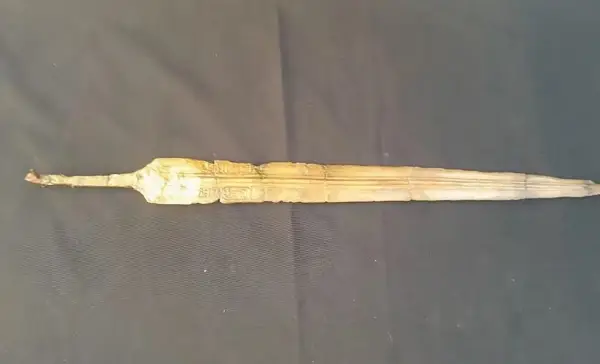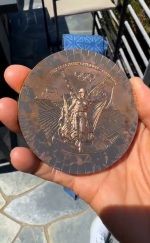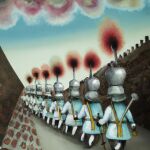Incredible! Ramses II sword found in Egypt that shines after 3,000 years
Discover a sword of Ramses II in Egypt that shines after 3,000 years. An impressive finding in an ancient fortress of the Nile delta!...
Table of Contents
- A breath-taking discovery
- Ramses II: More than a Pharaoh, an Icon
- A glimpse into daily life at the fortress
- The story behind the battles
Follow Patricia Alegsa on Pinterest!
A breath-taking discovery
Imagine unearthing a treasure that transports you to another time, to a period where pharaohs not only ruled but were also war heroes, architects of wonders, and of course, lovers of shining swords.
Recently, a group of archaeologists did just that: they found a bronze sword with the emblem of Ramses II, the pharaoh who claimed history.
Can you imagine holding a piece of Egypt's golden age in your hands? It's like Indiana Jones had a niece!
This discovery occurred at the Tell Al-Abqain fortress, an ancient outpost that, according to experts, played a crucial role in the defense of Egypt's borders.
This discovery occurred at the Tell Al-Abqain fortress, an ancient outpost that, according to experts, played a crucial role in the defense of Egypt's borders.
You have to admit it's fascinating to think that over 3,000 years ago, someone decided to leave their sword in a mud hut, like leaving keys on a table. But who was the owner of this weapon? That's a mystery that archaeologists are eager to solve.
They discover how Pharaoh Ramses III was murdered
If you've ever wondered who the most powerful pharaoh of Egypt was, the answer is clear: Ramses II, the Great. He ruled from 1279 to 1213 BC, a period that many consider the peak of Egyptian military power. This man not only made monumental architecture flourish, but he is also said to have been the pharaoh who lived during the time of Moses. Coincidence? History is full of unexpected twists.
Elizabeth Frood, an Egyptologist from Oxford, expressed that this sword reflects the status of its owner. Was he a high-ranking warrior? A noble who wanted to impress at court? What is clear is that carrying an object with Ramses II's insignia was not something just anyone could do. It was like having a sports car in a suburban neighborhood.
Archaeologists also discovered intriguing details about the daily life of soldiers. They found ovens for cooking, ivory applicators for kohl (a very popular cosmetic in Egypt), and ceremonial scarabs. These elements tell us that, despite military life, there was room for art and aesthetics. Even soldiers needed to look good while defending their homeland!
The cylindrical ovens found indicate that gastronomy also had its place in the daily routine. Can you imagine a soldier cooking his dinner after a hard day of training? Perhaps some even ventured to invent a secret recipe.
The Tell Al-Abqain fortress is located on a defensive line against Libyan tribes and the feared “Sea Peoples.” These Mediterranean warriors were like the pirates from the stories we heard as children, but much more dangerous.
They discover how Pharaoh Ramses III was murdered
Ramses II: More than a Pharaoh, an Icon
If you've ever wondered who the most powerful pharaoh of Egypt was, the answer is clear: Ramses II, the Great. He ruled from 1279 to 1213 BC, a period that many consider the peak of Egyptian military power. This man not only made monumental architecture flourish, but he is also said to have been the pharaoh who lived during the time of Moses. Coincidence? History is full of unexpected twists.
Elizabeth Frood, an Egyptologist from Oxford, expressed that this sword reflects the status of its owner. Was he a high-ranking warrior? A noble who wanted to impress at court? What is clear is that carrying an object with Ramses II's insignia was not something just anyone could do. It was like having a sports car in a suburban neighborhood.
A glimpse into daily life at the fortress
Archaeologists also discovered intriguing details about the daily life of soldiers. They found ovens for cooking, ivory applicators for kohl (a very popular cosmetic in Egypt), and ceremonial scarabs. These elements tell us that, despite military life, there was room for art and aesthetics. Even soldiers needed to look good while defending their homeland!
The cylindrical ovens found indicate that gastronomy also had its place in the daily routine. Can you imagine a soldier cooking his dinner after a hard day of training? Perhaps some even ventured to invent a secret recipe.
The story behind the battles
The Tell Al-Abqain fortress is located on a defensive line against Libyan tribes and the feared “Sea Peoples.” These Mediterranean warriors were like the pirates from the stories we heard as children, but much more dangerous.
As more structures were excavated, the story of an Egypt struggling to maintain its territory was revealed. The inscriptions of the battles tell heroic tales that could rival any modern action movie.
The construction of this fortress and its organized layout reflect the meticulous management of ancient Egypt. Soldiers not only fought but also lived and organized themselves in a way that everyday life was in harmony with military duty. Can you imagine the discipline that required?
So, while archaeologists continue to unearth secrets from the past, we are left with the curiosity of what is to come. Each finding is another step towards understanding the rich history of a civilization that left us an impressive legacy.
The construction of this fortress and its organized layout reflect the meticulous management of ancient Egypt. Soldiers not only fought but also lived and organized themselves in a way that everyday life was in harmony with military duty. Can you imagine the discipline that required?
So, while archaeologists continue to unearth secrets from the past, we are left with the curiosity of what is to come. Each finding is another step towards understanding the rich history of a civilization that left us an impressive legacy.
And who knows! Perhaps the next sword they find will have something even more surprising to tell us.
Subscribe to the free weekly horoscope
Aquarius Aries Cancer Capricorn Gemini Leo Libra Pisces Sagittarius Scorpio Taurus Virgo
-
 Is Life Expectancy Stagnating? New Studies Reveal the Truth
Is Life Expectancy Stagnating? New Studies Reveal the Truth
Life expectancy is slowing down: studies reveal that medical advances no longer boost longevity as they used to. Have we reached the human limit? -
 Machines are surpassing humans in skills and intelligence: the milestones
Machines are surpassing humans in skills and intelligence: the milestones
Machines in power! AI has defeated humans in chess, contests, and ancient games. Who said machines don't have brains? -
 The incredible story of the millionaire eaten by cannibals
The incredible story of the millionaire eaten by cannibals
The Mystery of Michael Rockefeller: The young photographer who left New York to live with cannibals and disappeared in the New Guinea jungle in 1961. -
 Proteins and genetic factors that affect brain health
Proteins and genetic factors that affect brain health
Discover how proteins affect brain communication, leading to neuronal death. Learn about the genetic and lifestyle factors that increase the risk. -
 Tragedy in Bavaria: Influencer dies while taking a photo in a castle
Tragedy in Bavaria: Influencer dies while taking a photo in a castle
Tragic death of 23-year-old gymnast Natalie Stichova after falling 80 meters while taking a risky photo in Bavaria, near the Sleeping Beauty Castle.
I am Patricia Alegsa
I have been writing horoscope and self-help articles professionally for over 20 years.
Subscribe to the free weekly horoscope
Receive weekly in your email the horoscope and our new articles on love, family, work, dreams and more news. We do NOT send spam.
Astral and numerological analysis
-
 Discover your future, secret personality traits and how to improve in love, business and life in general
Discover your future, secret personality traits and how to improve in love, business and life in general
-
 Online Dream Interpreter: with artificial intelligence
Do you want to know what a dream you had means? Discover the power of understanding your dreams with our advanced online dream interpreter using artificial intelligence that responds to you in seconds.
Online Dream Interpreter: with artificial intelligence
Do you want to know what a dream you had means? Discover the power of understanding your dreams with our advanced online dream interpreter using artificial intelligence that responds to you in seconds.
-
 The viral photograph that defies logic! Where is the woman's head?
The viral photograph that defies logic! Where is the woman's head?
A photograph that has gone viral in recent days shows a headless woman in what appears to be a beauty salon: Where is her head? -
 Birth Crisis: Are We Heading Towards a Childless World?
Birth Crisis: Are We Heading Towards a Childless World?
Are we heading towards a childless world? Plummeting birth rates, aging population. Can we reverse it? Infobae consults experts to explore the consequences. -
 Third World War, experts analyze if we are close to war
Third World War, experts analyze if we are close to war
Third World War in 2024? Discover what experts think about the growing global violence and current conflicts. Get informed here! -
 Medals from the Paris 2024 Olympics are deteriorating rapidly!
Medals from the Paris 2024 Olympics are deteriorating rapidly!
Olympic scandal! Paris 2024 medals are wearing out. Over 100 complaints and dismissals. Are the medals made of chewing gum? -
 Revolutionary therapy for hormonal deficiency: the case of Messi
Revolutionary therapy for hormonal deficiency: the case of Messi
Discover the innovative diagnosis of Leo Messi at 19 years old and the new therapy that could revolutionize the treatment of somatropin deficiency. -
 Curious websites that are like invaluable jewels: discover them
Curious websites that are like invaluable jewels: discover them
This list of websites, which you probably didn't know about, will delight you. They are little-known websites, but extremely useful or entertaining. -
 The complete disappearance of an Inuit people in Canada: the truth that nobody tells
The complete disappearance of an Inuit people in Canada: the truth that nobody tells
Discover the fascinating story behind the mysterious disappearance of an Inuit people in Nunavut, Canada, 90 years ago. Was it a mass migration, an extraterrestrial abduction, or simply an urban legend? A narrative full of mysteries, investigations, and theories that will keep your curiosity awake. -
 What does it mean to dream of dangers?
What does it mean to dream of dangers?
Discover in our article What does it mean to dream of danger? the meaning of dreams that alert you to threatening situations and how to interpret them to protect yourself. -
 What does it mean to dream of furniture?
What does it mean to dream of furniture?
Discover the fascinating interpretation of dreams with furniture and how these objects can reveal secrets about your past and future. Read now! -
 What does it mean to dream of an army?
What does it mean to dream of an army?
Discover the meaning behind your army dreams and how they can influence your life. Find answers and tips to make better decisions in this informative article. -
 What does it mean to dream of squid?
What does it mean to dream of squid?
Discover the meaning behind your dreams with squid. Do they represent hidden fears or an opportunity for prosperity? Find answers in this article. -
 Free online psychological therapy: with artificial intelligence
Free online psychological therapy: with artificial intelligence
Explore our innovative free online psychological therapy with artificial intelligence. Consult your emotional problems at any time and receive practical and confidential solutions. Improve your well-being from the comfort of your home! -
 Find out why guys misinterpret your interest according to your zodiac sign
Find out why guys misinterpret your interest according to your zodiac sign
Discover how to improve your impression with the guy you like according to your horoscope sign. Avoid mistakes and conquer him!